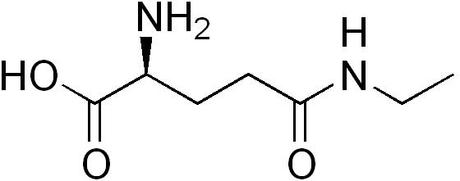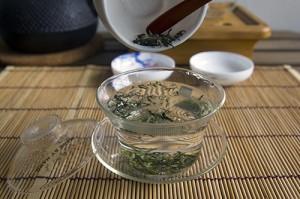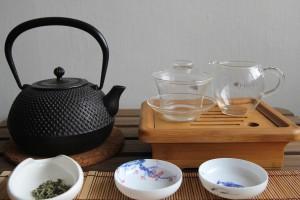Ever wondered how tea can stimulate and relax you concurrently?
The answer lies in the presence of 2 chemical compounds- caffeine and L-theanine.
Most people are more familiar with caffeine- a central nervous and metabolism stimulant that occurs naturally in a number of plants such as coffee beans, cocoa and tea. It is used to heighten alertness and ward off fatigue with varying effect on individuals.
L-theanine is a type of amino acid that occurs naturally in tea and to a lesser extent, certain types of mushrooms.
How then can tea be relaxing?
Many point to the ritualistic calm of preparing tea- especially if you follow the Chinese or Japanese ceremonial styles. The act of observing the tea leaves unfurl and swirl in an enchanting dance, the smelling of the pleasing aroma and gorgeous color, while waiting patiently for the leaves to infuse- the antithesis to our microwave culture.
Yet it is more than just a psychological effect.

Source from Wikicommons
Since the 80s, L-theanine has been the subject of numerous medical researches. One of the many benefits attributable to L-theanine is its effect on reducing stress which runs as a counter to caffeine.
This confirms what tea lovers have always known- the unique ability of tea to simultaneously rejuvenate and relax.
In the Tang Dynasty, the tea sage Lu Yu’s contemporary Hao Ran wrote a beautiful verse about this characteristic of tea:
“一饮涤昏寐, 情思爽朗满天地。
再饮清我神, 忽如飞雨洒轻尘。
三饮便得道, 何须苦心破烦恼。”
Loosely translated it means:
“The first bowl of tea dispels lethargy and raises the spirit, bringing light to the day,
The second bowl is like a spring drizzle, gently clearing the mind of distraction,
The third bowl brings about the truth and dispels depression”
Though poetic and undoubtedly hyperbolic, it does illustrate that for more than a millennium, scholars have written about the dual effect of tea.
The Perfect Foil to Caffeine
How L-theanine acts as a counter to caffeine is not restricted to this physical effect, it affects the taste as well.
Caffeine is bitter. I think this much is not disputed.
Caffeine is also higher in concentration in tender leaves, particularly buds (more information on this subject can be found here).
Hence there is this interesting theory I have read online that higher grade teas- where the authors often mistake buds for higher grade (generally true but not always, particularly for oolong and dark teas)- are higher in caffeine and hence more bitter.
My first reaction upon reading that is that the author probably has never tasted high quality teas.

The answer lies in the presence of L-theanine which is more prevalent in buds (more on that later).
A very common word in Chinese used to describe the taste of tea is “甘” (gan) or sweet- the same word that is used in “huigan”. But “甘” is often distinct from “甜” (tian)- another common word to describe sweetness- in that gan is more often than not preceded by bitterness.
This is also a unique quality in tea- this bittersweet taste that is aptly reminiscent of life.
Another quality about L-theanine that your taste buds will tell you all about is the brisk, lively quality. It is this quality that changes the initial astringency to a refreshing, delightful aftertaste for green teas especially.
Is this present in all teas?
In simplicity, L-theanine is present in all teas but the content varies significantly.
In 1994, Zhao He Tao studied the L-theanine content across the 6 basic categories of tea and compiled the following table:
mg/100g
Category Black Green Tea Yellow Tea Oolong Tea White Tea Dark Tea
Variety Qimen Black Songlo Mengding Yellow Tea Wuyi Yancha Silver Needles Puer
L-theanine
1416.6
1944.7
1730.1
627.4
3007.9
71.1
Total amino acid content
2355.4
2780.0
2635.5
1117.1
4751.7
183.4
Table 1
As seen, the highest content of L-theanine is found in Silver Needles.
*As a side note- this is why much research from non-tea producing nations are not very useful- instead of saying “black tea, white tea etc” identifying the variety allows us a better understanding of what factors influence certain data.*
What impacts L-theanine and amino acid is due to a few factors but let’s just look at 3.
Picking Requirements
This is the L-theanine content of raw leaves on the amount of mg/100g:

2nd leaf: 146.00
3rd leaf: 127.80
4th leaf: 100.00
5th leaf: 94.70
(Source: 制茶学 by 中国农业出版社)
As shown, the L-theanine content is higher in younger leaves. This would partially explain why Silver Needles (which is a bud only tea) has a much higher L-theanine content than dark tea which is made from matured leaves.
My guess on what the other picking ratios are:
Qimen Black: 1 bud to 2 leaves (it was the norm at that time, buds only became prevalent in the last decade)
Songlo: 1 bud to 1-2 leaves
Mengding Yellow tea: since not explicitly stated- it’s probably not Mending Huangya (buds only), hence 1 bud to 1-2 leaves should be the norm
Wuyi Yancha- 1 bud to 3 leaves
Puer: 3-5 leaves ratio
Cultivar
A cultivar is a “sub-species” of the Camellia Sinensis plant which can be naturally occurring or due to human induced factors.
*For more information on what is a cultivar, please refer to this article.
Here are some cultivars that appear in Table 1 to illustrate:
i) Camellia sinensis CV. Keemenzhong- used in Qimen Black- content of amino acid in 1 leaf 2 bud ratio- 3.5%
ii) Camellia sinensis CV. Fuding- dabaicha- used in Silver Needles- content of amino acid in 1 leaf 2 bud ratio- 4.3%
iii) Camellia sinensis CV. Fujian-shuixian: used in Wuyi Yancha- content of amino acid in 1 leaf 2 bud ratio- 2.6%
iv) Camellia sinensis var. assamica CV Mengku Dayecha- used in Puer- content of amino acid in 1 leaf 2 bud ratio – 1.7%
(Source: 茶学概论 by 周巨根 et al)
Comparing the dabaicha cultivar against the mengku dayecha, it is 4.3% versus 1.7%, which again further explains the gulf.
Processing Method
There is a lot of detail to go into but the biggest impact is on the “wodui” stage that dark teas go through. The fermentation process alters the L-theanine content radically.
See here for other frequently asked tea related questions
See here for more articles related to tea and health
Information was researched and compiled from
1) 茶与健康 by 屠幼英
2) 茶医学研究 by 朱永兴 & 王岳飞 et al
